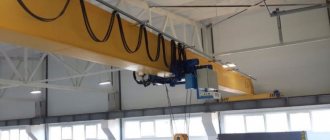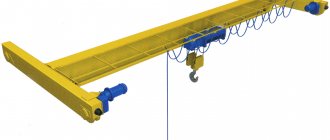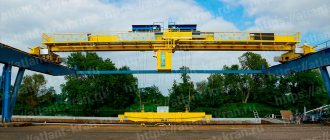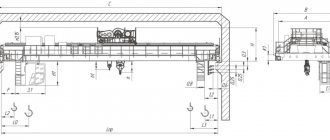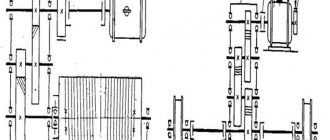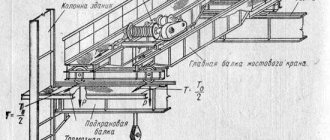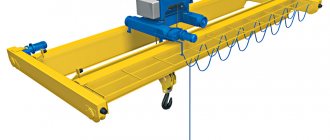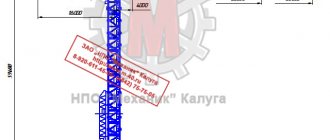Industry plays a special role in the economic state of any state. It is an indicator of power and solvency. A properly functioning industrial sector makes it possible to receive a significant increase in funds for the state treasury.
To form a properly functioning complex, it is necessary to have special auxiliary mechanisms and devices. Cranes, in this regard, play a leading role. They are often used in construction and installation work, in the production and industrial cycle.
Overhead crane
An overhead crane has a clear definition according to GOST ISO 4306-1:2007. In accordance with the state standard, a crane is equipment with lifting elements for carrying loads over various distances. It is a steel platform that is perpendicularly attached to the bridge and moves along suspended or support-type crane tracks. The standard equipment for bridge equipment includes:
- Crane trolley with 1 or 2 lifting mechanisms;
- Cable or trolley conductors;
- Control unit (radio remote control or operator's cabin).
Very often it has two supporting platforms. Depending on the type of cargo, there are hook, grab, cast, magnetic and other types of grip units.
Separately, it is worth noting the load-carrying capacity of a full-fledged mechanism. The range available to bridge engineering ranges from 3-1000 tons depending on the characteristics of the structure. Can move at a speed of 10 m/sec.
Installing a bridge device is quite labor-intensive and requires special equipment. Possible options:
- Fastening the beam under the movable base;
- Fastening the beam to a movable base.
The main advantage of the bridge structure is high speed of operation, good load capacity, large working area, mobility of the crane trolley, work with explosive and magnetic loads.
Structural differences
The precise definition of MC is given in ISO 4306-1:2007. According to these standards, it is an overhead crane, which is equipped with bridges installed directly on the crane runway. The crane beam, in turn, is defined as a type of bridge, significantly lightweight. Its design is simplified and includes a main beam and a hoist moving along it. Mobility is ensured by end beams with wheels that ride on the rails of the crane tracks.
An overhead crane has a more complex design. Its central part is a bridge, in the form of end beams, rigidly connected to each other. The bridge is located parallel to the direction of the crane tracks, and the main beams lie perpendicular to them. If the crane beam is only single-beam, then the pavement often has two beam elements. The mobility of an overhead crane, like a beam crane, is ensured along the crane tracks along which the bridge travels. At the same time, the crane trolley itself can move across them - along the main beam.
Unlike its simplified counterpart, the overhead crane is equipped with automated systems - electric lifting hoists and electric hoists. They are controlled remotely - from a radio remote control. The overhead cranes are also equipped with trolley current leads and busbar ducts.
Cathead
A simplified analogue of an overhead crane is a beam crane. Mandatory components of lightweight equipment are:
- Main beam with installed running wheels;
- Mobile hoist or hoist with a gripping unit;
- Control panel on a cable or radio element.
The mobility of the installation is ensured by mounting the wheels directly on the beam for movement on rails. There are no additional reinforcing bridges in the design.
A beam crane and an overhead crane do not differ in the type of beam fastening. Both types of equipment can be equipped with a supporting and suspended platform. The length of the working area of a simplified type structure is from 3 to 12 meters, the maximum lifting height is up to 30 meters.
The maximum permissible load capacity for the beam is about 10 tons. Models with a range of 1-5 tons are widespread. The available speed of movement of the gripping mechanism in the mobile beam is 0.5-1 m/sec.
The main advantages of lightweight technology remain the ability to save space, ease of installation and maintenance, and low energy consumption.
Application area
Small dimensions, simple design and low weight of the crane beam allow it to be used in limited spaces. It is used for transporting small-tonnage cargo in assembly shops, car services, warehouses, private workshops, etc. Installing an overhead crane beam (or support) is much simpler than installing an overhead crane, which is also a plus. Operation of the equipment is possible at low temperatures and conditions of high humidity.
A more powerful overhead crane is used in various industrial fields: auto-shipbuilding, metallurgy, woodworking, reinforced concrete factories, etc. It is used in construction, the oil and gas industry, and installed in ports. Can be used inside workshops/production premises and outdoors.
Thus, the differences between a girder crane and an overhead crane are obvious, both in design and functionality. This allows you to select the equipment that is optimal in terms of power, configuration and cost to perform specific production tasks.
TekhKranMontazh offers a wide range of beam cranes and overhead cranes of different lifting capacities. We will select the optimal equipment, deliver it to the site and perform installation.
Main differences and scope of application
In addition to design differences, both types have a number of features that determine the method of their installation. The crane runway of the beam crane does not provide for the installation of additional supports. The mechanism can be mounted directly to the ceiling in accordance with safety requirements.
Beam-type devices are used in small workshops and covered warehouses with limited space. Bridge equipment is installed in the workshops of steel mills, in ports, and in large-scale production. In open areas, a gantry-type overhead crane is used on special mobile supports.
Functional differences
The beam crane is most often used in small workshops, on closed overpasses or in warehouses. It is used where it is necessary to move relatively light weight loads. This technique saves space, so it is relevant in rooms with limited space.
An overhead crane has a greater lifting capacity. If beam cranes are capable of working with objects weighing up to 7.5 tons, then overhead cranes (depending on the type) can lift up to 160 and even 1000 tons. They are installed in the largest production workshops and warehouses, both closed and open.
Necessary conditions for installing a crane
Before you begin installing the crane beam, you should make sure that the building can withstand the loads that arise during operation. The assembly process is carried out in several stages:
- delivery of all mechanisms to the assembly site;
- installation of the unit on crane tracks;
- lifting and installation of the bridge;
- final installation steps.
Before installing the crane, the following preliminary work should be done:
Design of the crane runway of the support crane beam
- complete the installation of metal structures for at least 5-6 spans;
- install and check crane tracks;
- make sure there is a railway track on the site;
- calculate the length of the installation area - it should be twice as long as the bridge.
After receiving the certificate of completion of the preparatory work, installation of the installation can begin.
Affordable prices, ease of assembly, and good performance indicators have ensured that the beam crane is highly popular among customers. They often act as the only possible option for carrying out lifting work in hard-to-reach places.
Load-handling devices
Various types of load-handling devices are used for beam cranes:
- crane hooks,
- pins,
- cargo forks,
- pincer grips,
- magnetic,
- vacuum, etc.
The simplest and most common type of load-handling device is a hook. It can be one-horned or two-horned.
Less commonly used are magnetic devices - for lifting flat and round objects, and vacuum devices - driven by compressed air or using fan-type vacuum electric pumps, used in textile and paper production.
Advantages of using this type of cranes
Electric overhead overhead crane with control panel
Lifting equipment of this type can be easily operated in a fairly wide temperature range, which varies from -20 to +40 degrees Celsius.
In some cases, the equipment is supplemented with several more lifting mechanisms. Fortunately, the design features of overhead overhead cranes allow this. All overhead overhead cranes are reliable and safe.
At the same time, their stability is always at its best. It is thanks to these properties that overhead cranes of this type have become widespread.
So, we can highlight the following positive features of overhead support cranes:
- Sufficiently high speed of installation and dismantling. This is achieved due to the simplicity of the design and all its components;
- Low cost of equipment. This mainly applies to manual taps, but electric models in most cases are also low in cost;
- Easy to maintain. Almost any worker with the appropriate profile and specialization can handle the repair task;
- Maintainability of both the crane runways and the crane itself.
- Light weight;
- Simplicity of design;
All these advantages make overhead overhead cranes one of the most common in modern industry. Almost no modern production can be imagined without such equipment.
Device
A distinctive feature of an overhead crane beam is a bridge, a span beam mounted on end beams resting on the crane tracks. A hoist moves along the bridge, allowing the load to be operated in the vertical and transverse axes. The bridge itself moves along the crane tracks, ensuring the movement of cargo in the longitudinal direction. The bridge is made of rolled steel, has an I-beam or box section, and can consist of one or two beams. The double girder overhead crane bridge provides increased lifting capacity and stability, which is important when transporting massive or critical loads.
For a suspended crane beam, the device may involve a two-span design - two bridge beams are connected end-to-end and rigidly attached to the middle end beam - this allows you to increase the width of the working area (span) to 24 m.
The connection of the bridge with the end beams of the crane on suspended machines is often floating in order to ensure better contact with the crane tracks, eliminate the risk of jamming, distortions when the crane tracks deviate slightly from straightness, and prevent the crane beam from coming off the tracks.
The end beams of the support crane , as a rule, are rigidly connected to the bridge, their fastening is reinforced by braces. They are equipped with a gear motor that drives single- or double-flanged running wheels.
Types of drives
The crane design uses two types of drives.
Manual overhead crane - device diagram
Manual is cheaper and easier to operate. It is usually installed when lifting small masses and dimensions, and provides a low speed of movement of the hoist compared to an electric one.
The manual mechanism is used less and less; it gives low productivity, as it is driven by the worker’s muscle power. It operates using a shaft connected to running wheels and is more often used in small repair shops or artisanal workshops and warehouses. Manually driven beam cranes have the following characteristics: lifting capacity – up to 10 tons; span – 20 t.
Undoubtedly, the electric drive has higher performance characteristics; it also has the greatest application. The movement of cargo in it is ensured by an electric motor, a gearbox and a transmission shaft, which transmits rotation via gears to the wheels of the cargo trolley. The electric drive is designed for high performance:
- significant carrying capacity;
- intensive use of crane equipment;
- high labor productivity.
At the same time, the electric drive significantly increases the weight of the lifting mechanism and the entire structure as a whole.
The electric motor can be controlled:
- from the operator's cabin located at the level of the crane beam;
- using a wired remote control;
- via radio control is the most convenient option.
Electrically driven overhead cranes
